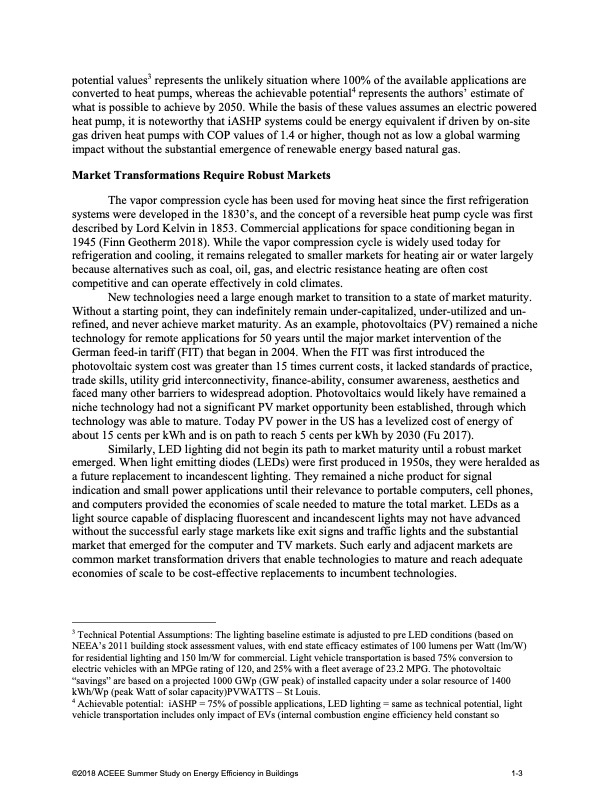
PDF Publication Title:
Text from PDF Page: 003
potential values3 represents the unlikely situation where 100% of the available applications are converted to heat pumps, whereas the achievable potential4 represents the authors’ estimate of what is possible to achieve by 2050. While the basis of these values assumes an electric powered heat pump, it is noteworthy that iASHP systems could be energy equivalent if driven by on-site gas driven heat pumps with COP values of 1.4 or higher, though not as low a global warming impact without the substantial emergence of renewable energy based natural gas. Market Transformations Require Robust Markets The vapor compression cycle has been used for moving heat since the first refrigeration systems were developed in the 1830’s, and the concept of a reversible heat pump cycle was first described by Lord Kelvin in 1853. Commercial applications for space conditioning began in 1945 (Finn Geotherm 2018). While the vapor compression cycle is widely used today for refrigeration and cooling, it remains relegated to smaller markets for heating air or water largely because alternatives such as coal, oil, gas, and electric resistance heating are often cost competitive and can operate effectively in cold climates. New technologies need a large enough market to transition to a state of market maturity. Without a starting point, they can indefinitely remain under-capitalized, under-utilized and un- refined, and never achieve market maturity. As an example, photovoltaics (PV) remained a niche technology for remote applications for 50 years until the major market intervention of the German feed-in tariff (FIT) that began in 2004. When the FIT was first introduced the photovoltaic system cost was greater than 15 times current costs, it lacked standards of practice, trade skills, utility grid interconnectivity, finance-ability, consumer awareness, aesthetics and faced many other barriers to widespread adoption. Photovoltaics would likely have remained a niche technology had not a significant PV market opportunity been established, through which technology was able to mature. Today PV power in the US has a levelized cost of energy of about 15 cents per kWh and is on path to reach 5 cents per kWh by 2030 (Fu 2017). Similarly, LED lighting did not begin its path to market maturity until a robust market emerged. When light emitting diodes (LEDs) were first produced in 1950s, they were heralded as a future replacement to incandescent lighting. They remained a niche product for signal indication and small power applications until their relevance to portable computers, cell phones, and computers provided the economies of scale needed to mature the total market. LEDs as a light source capable of displacing fluorescent and incandescent lights may not have advanced without the successful early stage markets like exit signs and traffic lights and the substantial market that emerged for the computer and TV markets. Such early and adjacent markets are common market transformation drivers that enable technologies to mature and reach adequate economies of scale to be cost-effective replacements to incumbent technologies. 3 Technical Potential Assumptions: The lighting baseline estimate is adjusted to pre LED conditions (based on NEEA’s 2011 building stock assessment values, with end state efficacy estimates of 100 lumens per Watt (lm/W) for residential lighting and 150 lm/W for commercial. Light vehicle transportation is based 75% conversion to electric vehicles with an MPGe rating of 120, and 25% with a fleet average of 23.2 MPG. The photovoltaic “savings” are based on a projected 1000 GWp (GW peak) of installed capacity under a solar resource of 1400 kWh/Wp (peak Watt of solar capacity)PVWATTS – St Louis. 4 Achievable potential: iASHP = 75% of possible applications, LED lighting = same as technical potential, light vehicle transportation includes only impact of EVs (internal combustion engine efficiency held constant so ©2018 ACEEE Summer Study on Energy Efficiency in Buildings 1-3PDF Image | Lync Diagram

PDF Search Title:
Lync DiagramOriginal File Name Searched:
2018-aceei.pdfDIY PDF Search: Google It | Yahoo | Bing
CO2 Organic Rankine Cycle Experimenter Platform The supercritical CO2 phase change system is both a heat pump and organic rankine cycle which can be used for those purposes and as a supercritical extractor for advanced subcritical and supercritical extraction technology. Uses include producing nanoparticles, precious metal CO2 extraction, lithium battery recycling, and other applications... More Info
Heat Pumps CO2 ORC Heat Pump System Platform More Info
| CONTACT TEL: 608-238-6001 Email: greg@infinityturbine.com | RSS | AMP |